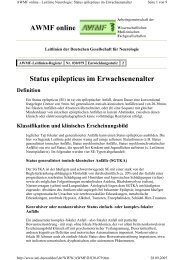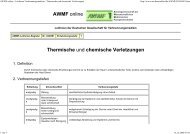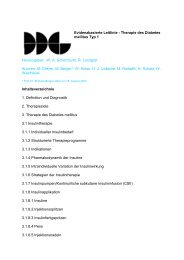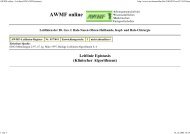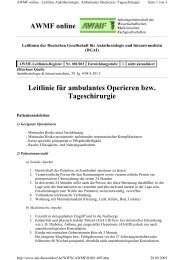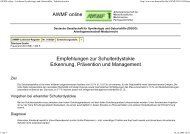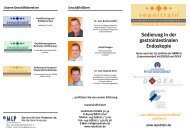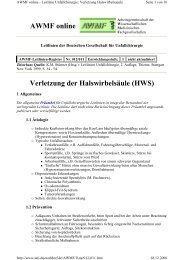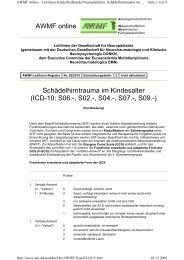Kreislaufstillstand unter besonderen Umständen ... - Reanitrain
Kreislaufstillstand unter besonderen Umständen ... - Reanitrain
Kreislaufstillstand unter besonderen Umständen ... - Reanitrain
Erfolgreiche ePaper selbst erstellen
Machen Sie aus Ihren PDF Publikationen ein blätterbares Flipbook mit unserer einzigartigen Google optimierten e-Paper Software.
29. Krenzelok EP, McGuigan M, Lheur P (1997) Position<br />
statement: ipecac syrup. American Academy<br />
of Clinical Toxicology European Association of Poisons<br />
Centres and Clinical Toxicologists. J Toxicol<br />
Clin Toxicol 35:699–709<br />
30. Chyka PA, Seger D, Krenzelok EP, Vale JA (2005)<br />
Position paper: Single-dose activated charcoal.<br />
Clin Toxicol (Phila) 43:61–87<br />
31. (o A) (2004) Position paper: whole bowel irrigation.<br />
J Toxicol Clin Toxicol 42:843–854<br />
32. Krenzelok EP (2005) Ipecac syrup-induced emesis…no<br />
evidence of benefit. Clin Toxicol (Phila)<br />
43:11–12<br />
33. (o A) (2004) Position paper: Ipecac syrup. J Toxicol<br />
Clin Toxicol 42:133–143<br />
34. Pitetti RD, Singh S, Pierce MC (2003) Safe and efficacious<br />
use of procedural sedation and analgesia<br />
by nonanesthesiologists in a pediatric emergency<br />
department. Arch Pediatr Adolesc Med 157:1090–<br />
1096<br />
35. (o A) (1992) Treatment of benzodiazepine overdose<br />
with flumazenil. The Flumazenil in Benzodiazepine<br />
Intoxication Multicenter Study Group. Clin<br />
Ther 14:978–995<br />
36. Lheureux P, Vranckx M, Leduc D, Askenasi R (1992)<br />
Flumazenil in mixed benzodiazepine/tricyclic antidepressant<br />
overdose: a placebo-controlled study<br />
in the dog. Am J Emerg Med 10:184–188<br />
37. Beauvoir C, Passeron D, du Cailar G, Millet E (1991)<br />
Diltiazem poisoning: hemodynamic aspects. Ann<br />
Fr Anesth Reanim 10:154–157<br />
38. Gillart T, Loiseau S, Azarnoush K et al (2008) Resuscitation<br />
after three hours of cardiac arrest with<br />
severe hypothermia following a toxic coma. Ann<br />
Fr Anesth Reanim 27:510–513<br />
39. Nordt SP, Clark RF (1997) Midazolam: a review<br />
of therapeutic uses and toxicity. J Emerg Med<br />
15:357–365<br />
40. Machin KL, Caulkett NA (1998) Cardiopulmonary<br />
effects of propofol and a medetomidinemidazolam-<br />
ketamine combination in mallard ducks. Am<br />
J Vet Res 59:598–602<br />
41. Osterwalder JJ (1996) Naloxone – for intoxications<br />
with intravenous heroin and heroin mixtures –<br />
harmless or hazardous? A prospective clinical study.<br />
J Toxicol Clin Toxicol 34:409–416<br />
42. Sporer KA, Firestone J, Isaacs SM (1996) Out-ofhospital<br />
treatment of opioid overdoses in an urban<br />
setting. Acad Emerg Med 3:660–667<br />
43. Wanger K, Brough L, Macmillan I et al (1998) Intravenous<br />
vs subcutaneous naloxone for out-of-hospital<br />
management of presumed opioid overdose.<br />
Acad Emerg Med 5:293–299<br />
44. Hasan RA, Benko AS, Nolan BM et al (2003) Cardiorespiratory<br />
effects of naloxone in children. Ann<br />
Pharmacother 37:1587–1592<br />
45. Sporer KA (1999) Acute heroin overdose. Ann Intern<br />
Med 130:584–590<br />
46. Kaplan JL, Marx JA, Calabro JJ et al (1999) Doubleblind,<br />
randomized study of nalmefene and naloxone<br />
in emergency department patients with<br />
suspected narcotic overdose. Ann Emerg Med<br />
34:42–50<br />
47. Schneir AB, Vadeboncoeur TF, Offerman SR et al<br />
(2002) Massive OxyContin ingestion refractory to<br />
naloxone therapy. Ann Emerg Med 40:425–428<br />
48. Kelly AM, Kerr D, Dietze P et al (2005) Randomised<br />
trial of intranasal versus intramuscular naloxone<br />
in prehospital treatment for suspected opioid<br />
overdose. Med J Aust 182:24–27<br />
49. Robertson TM, Hendey GW, Stroh G, Shalit M<br />
(2009) Intranasal naloxone is a viable alternative<br />
to intravenous naloxone for prehospital narcotic<br />
overdose. Prehosp Emerg Care 13:512–515<br />
50. Tokarski GF, Young MJ (1988) Criteria for admitting<br />
patients with tricyclic antidepressant overdose.<br />
J Emerg Med 6:121–124<br />
51. Banahan BF Jr, Schelkun PH (1990) Tricyclic antidepressant<br />
overdose: conservative management<br />
in a community hospital with cost-saving implications.<br />
J Emerg Med 8:451–454<br />
52. Hulten BA, Adams R, Askenasi R et al (1992) Predicting<br />
severity of tricyclic antidepressant overdose.<br />
J Toxicol Clin Toxicol 30:161–170<br />
53. Bailey B, Buckley NA, Amre DK (2004) A meta-analysis<br />
of prognostic indicators to predict seizures,<br />
arrhythmias or death after tricyclic antidepressant<br />
overdose. J Toxicol Clin Toxicol 42:877–888<br />
54. Thanacoody HK, Thomas SH (2005) Tricyclic antidepressant<br />
poisoning: cardiovascular toxicity. Toxicol<br />
Rev 24:205–214<br />
55. Woolf AD, Erdman AR, Nelson LS et al (2007) Tricyclic<br />
antidepressant poisoning: an evidence-based<br />
consensus guideline for out-of-hospital management.<br />
Clin Toxicol (Phila) 45:203–233<br />
56. Hoffman JR, Votey SR, Bayer M, Silver L (1993) Effect<br />
of hypertonic sodium bicarbonate in the<br />
treatment of moderate-to-severe cyclic antidepressant<br />
overdose. Am J Emerg Med 11:336–341<br />
57. Koppel C, Wiegreffe A, Tenczer J (1992) Clinical<br />
course, therapy, outcome and analytical data in<br />
amitriptyline and combined amitriptyline/chlordiazepoxide<br />
overdose. Hum Exp Toxicol 11:458–<br />
465<br />
58. Brown TC (1976) Tricyclic antidepressant overdosage:<br />
experimental studies on the management<br />
of circulatory complications. Clin Toxicol 9:255–<br />
272<br />
59. Hedges JR, Baker PB, Tasset JJ et al (1985) Bicarbonate<br />
therapy for the cardiovascular toxicity of<br />
amitriptyline in an animal model. J Emerg Med<br />
3:253–260<br />
60. Knudsen K, Abrahamsson J (1997) Epinephrine<br />
and sodium bicarbonate independently and additively<br />
increase survival in experimental amitriptyline<br />
poisoning. Crit Care Med 25:669–674<br />
61. Nattel S, Mittleman M (1984) Treatment of ventricular<br />
tachyarrhythmias resulting from amitriptyline<br />
toxicity in dogs. J Pharmacol Exp Ther<br />
231:430–435<br />
62. Pentel P, Benowitz N (1984) Efficacy and mechanism<br />
of action of sodium bicarbonate in the treatment<br />
of desipramine toxicity in rats. J Pharmacol<br />
Exp Ther 230:12–19<br />
63. Sasyniuk BI, Jhamandas V, Valois M (1986) Experimental<br />
amitriptyline intoxication: treatment of<br />
cardiac toxicity with sodium bicarbonate. Ann<br />
Emerg Med 15:1052–1059<br />
64. Yoav G, Odelia G, Shaltiel C (2002) A lipid emulsion<br />
reduces mortality from clomipramine overdose<br />
in rats. Vet Hum Toxicol 44:30<br />
65. Harvey M, Cave G (2007) Intralipid outperforms<br />
sodium bicarbonate in a rabbit model of clomipramine<br />
toxicity. Ann Emerg Med 49:178–185,<br />
85 e1–e4<br />
66. Brunn GJ, Keyler DE, Pond SM, Pentel PR (1992)<br />
Reversal of desipramine toxicity in rats using<br />
drug-specific antibody Fab‘ fragment: effects on<br />
hypotension and interaction with sodium bicarbonate.<br />
J Pharmacol Exp Ther 260:1392–1399<br />
67. Brunn GJ, Keyler DE, Ross CA et al (1991) Drugspecific<br />
F(ab‘)2 fragment reduces desipramine<br />
cardiotoxicity in rats. Int J Immunopharmacol<br />
13:841–851<br />
68. Hursting MJ, Opheim KE, Raisys VA et al (1989) Tricyclic<br />
antidepressant-specific Fab fragments alter<br />
the distribution and elimination of desipramine in<br />
the rabbit: a model for overdose treatment. J Toxicol<br />
Clin Toxicol 27:53–66<br />
69. Pentel PR, Scarlett W, Ross CA et al (1995) Reduction<br />
of desipramine cardiotoxicity and prolongation<br />
of survival in rats with the use of polyclonal<br />
drugspecific antibody Fab fragments. Ann Emerg<br />
Med 26:334–341<br />
70. Pentel PR, Ross CA, Landon J et al (1994) Reversal<br />
of desipramine toxicity in rats with polyclonal<br />
drug-specific antibody Fab fragments. J Lab Clin<br />
Med 123:387–393<br />
71. Dart RC, Sidki A, Sullivan JB Jr et al (1996) Ovine<br />
desipramine antibody fragments reverse desipramine<br />
cardiovascular toxicity in the rat. Ann Emerg<br />
Med 27:309–315<br />
72. Heard K, Dart RC, Bogdan G et al (2006) A preliminary<br />
study of tricyclic antidepressant (TCA) ovine<br />
FAB for TCA toxicity. Clin Toxicol (Phila) 44:275–<br />
281<br />
73. Pentel P, Peterson CD (1980) Asystole complicating<br />
physostigmine treatment of tricyclic antidepressant<br />
overdose. Ann Emerg Med 9:588–590<br />
74. Lange RA, Cigarroa RG, Yancy CW Jr et al (1989)<br />
Cocaine-induced coronary-artery vasoconstriction.<br />
N Engl J Med 321:1557–1562<br />
75. Baumann BM, Perrone J, Hornig SE et al (2000)<br />
Randomized, doubleblind, placebo-controlled trial<br />
of diazepam, nitroglycerin, or both for treatment<br />
of patients with potential cocaine-associated<br />
acute coronary syndromes. Acad Emerg Med<br />
7:878–885<br />
76. Honderick T, Williams D, Seaberg D, Wears R<br />
(2003) A prospective, randomized, controlled trial<br />
of benzodiazepines and nitroglycerine or nitroglycerine<br />
alone in the treatment of cocaineassociated<br />
acute coronary syndromes. Am J Emerg<br />
Med 21:39–42<br />
77. Negus BH, Willard JE, Hillis LD et al (1994) Alleviation<br />
of cocaine-induced coronary vasoconstriction<br />
with intravenous verapamil. Am J Cardiol<br />
73:510–513<br />
78. Saland KE, Hillis LD, Lange RA, Cigarroa JE (2002)<br />
Influence of morphine sulfate on cocaine-induced<br />
coronary vasoconstriction. Am J Cardiol 90:810–<br />
811<br />
79. Brogan WCI, Lange RA, Kim AS et al (1991) Alleviation<br />
of cocaineinduced coronary vasoconstriction<br />
by nitroglycerin. J Am Coll Cardiol 18:581–586<br />
80. Hollander JE, Hoffman RS, Gennis P et al (1994)<br />
Nitroglycerin in the treatment of cocaine associated<br />
chest pain – clinical safety and efficacy. J Toxicol<br />
Clin Toxicol 32:243–256<br />
81. Dattilo PB, Hailpern SM, Fearon K et al (2008) Beta-blockers<br />
are associated with reduced risk of<br />
myocardial infarction after cocaine use. Ann<br />
Emerg Med 51:117–125<br />
82. Vongpatanasin W, Mansour Y, Chavoshan B et al<br />
(1999) Cocaine stimulates the human cardiovascular<br />
system via a central mechanism of action.<br />
Circulation 100:497–502<br />
83. Lange RA, Cigarroa RG, Flores ED et al (1990) Potentiation<br />
of cocaine-induced coronary vasoconstriction<br />
by beta-adrenergic blockade. Ann Intern<br />
Med 112:897–903<br />
84. Sand IC, Brody SL, Wrenn KD, Slovis CM (1991) Experience<br />
with esmolol for the treatment of cocaine-associated<br />
cardiovascular complications. Am J<br />
Emerg Med 9:161–163<br />
85. Sofuoglu M, Brown S, Babb DA et al (2000) Carvedilol<br />
affects the physiological and behavioral response<br />
to smoked cocaine in humans. Drug Alcohol<br />
Depend 60:69–76<br />
86. Sofuoglu M, Brown S, Babb DA et al (2000) Effects<br />
of labetalol treatment on the physiological and<br />
subjective response to smoked cocaine. Pharmacol<br />
Biochem Behav 65:255–259<br />
Notfall + Rettungsmedizin 7 · 2010 |<br />
713



